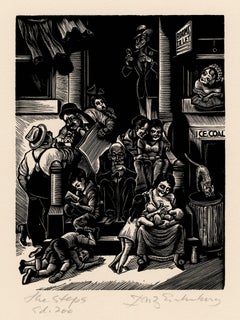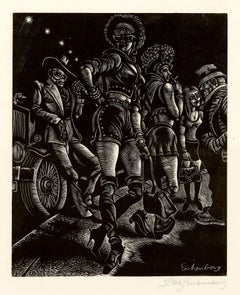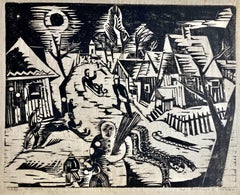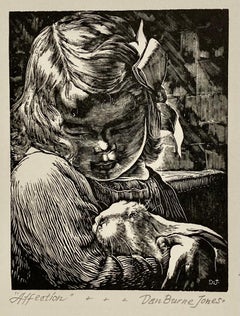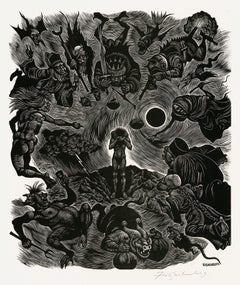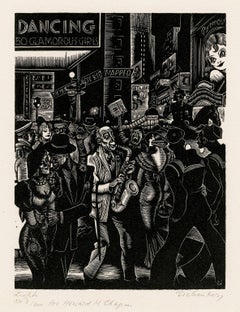Fritz Eichenberg. Figurative Prints
American, German, 1901-1990
Fritz Eichenberg was one of the world's most sought-after illustrators of literary classics, including The Brothers Karamazov and Crime and Punishment, as well as works by Edgar Allan Poe, Dylan Thomas, the Brontë sisters, and others. Born in Cologne, Germany in 1901, he learned lithography, wood-engraving, and etching and by his early twenties had produced masterful illustrations for Gulliver's Travels and Till Eulenspiegel. He came to the United States in 1933 and over the next five decades produced an astonishing range of individual images and book illustrations. Throughout his life, he was preoccupied with the tragedy of war. He became a close friend and great supporter of Dorothy Day and The Catholic Worker and used his art to express his hope for more justice in the world. to
3
Overall Width
to
Overall Height
to
3
4
846
382
379
308
3
2
1
3
3
3
2
1
1
1
1
1
3
3
Artist: Fritz Eichenberg.
'The Steps' — WPA Era Graphic Modernism
By Fritz Eichenberg
Located in Myrtle Beach, SC
Fritz Eichenberg, 'The Steps', wood engraving, 1933, edition 200. Signed, titled, and annotated 'Ed. 200' in pencil. Initialed in the block, lower right. A superb, richly-inked impr...
Category
1930s American Modern Fritz Eichenberg. Figurative Prints
Materials
Woodcut
'The Aquarium' — WPA Era Graphic Modernism
By Fritz Eichenberg
Located in Myrtle Beach, SC
Fritz Eichenberg, 'The Aquarium', wood engraving, 1933, edition 200. Signed and titled in pencil. Initialed in the block, lower right. A superb, richly-inked impression, on pale yel...
Category
1930s American Modern Fritz Eichenberg. Figurative Prints
Materials
Woodcut
'The Pimp' — Graphic Modernism
By Fritz Eichenberg
Located in Myrtle Beach, SC
Fritz Eichenberg, 'The Pimp', wood engraving, 1980, artist's proof before the edition. Signed in pencil. Signed in the block, lower right. A fine, richly-inked impression, on cream wove paper, with full margins (2 3/16 to 3 1/2 inches), in excellent condition. Archivally sleeved, unmatted.
Image size 12 x 9 3/4 inches (305 x 248 mm); sheet size 18 x 14 inches (457 x 356 mm).
ABOUT THE ARTIST
Fritz Eichenberg (1901–1990) was a German-American illustrator and arts educator who worked primarily in wood engraving. His best-known works were concerned with religion, social justice, and nonviolence.
Eichenberg was born to a Jewish family in Cologne, Germany, where the destruction of World War I helped to shape his anti-war sentiments. He worked as a printer's apprentice and studied at the Municipal School of Applied Arts in Cologne and the Academy of Graphic Arts in Leipzig, where he studied under Hugo Steiner-Prag. In 1923 he moved to Berlin to begin his career as an artist, producing illustrations for books and newspapers. In his newspaper and magazine work, Eichenberg was politically outspoken and sometimes wrote and illustrated his reporting.
In 1933, the rise of Adolf Hitler drove Eichenberg, who was a public critic of the Nazis, to emigrate with his wife and children to the United States. He settled in New York City, where he lived most of his life. He worked in the WPA Federal Arts Project and was a member of the Society of American Graphic Artists.
In his prolific career as a book illustrator, Eichenberg portrayed many forms of literature but specialized in works with elements of extreme spiritual and emotional conflict, fantasy, or social satire. Over his long career, Eichenberg was commissioned to illustrate more than 100 classics by publishers in the United States and abroad, including works by renowned authors Dostoyevsky, Tolstoy, Charlotte and Emily Brontë, Poe, Swift, and Grimmelshausen. He also wrote and illustrated books of folklore and children's stories.
Eichenberg was a long-time contributor to the progressive magazine The Nation, his illustrations appearing between 1930 and 1980. Eichenberg’s work has been featured by such esteemed publishers as The Heritage Club, Random House, Book of the Month Club, The Limited Editions Club, Kingsport Press, Aquarius Press, and Doubleday.
Raised in a non-religious family, Eichenberg had been attracted to Taoism as a child. Following his wife's unexpected death in 1937, he turned briefly to Zen Buddhist meditation, then joined the Religious Society of Friends in 1940. Though he remained a Quaker until his death, Eichenberg was also associated with Catholic charity work through his friendship with Dorothy Day...
Category
1980s American Modern Fritz Eichenberg. Figurative Prints
Materials
Woodcut
Related Items
Werner Drewes, Winter, 1933, modernist woodcut
By Werner Drewes
Located in New York, NY
A modernist fantasy winter scene created by Werner Drewes, this print brings key aspects of the period together. His cubist-inspired woodcut technique is utilized here to bring the s...
Category
1930s American Modern Fritz Eichenberg. Figurative Prints
Materials
Woodcut
Dan Burne Jones, Affection
Located in New York, NY
Dan Burne Jones is widely know as the author of the Rockwell Kent print catalogue raisonne. It's so interesting to see that he is a gifted wood engraver as well. Jones's own prints a...
Category
1930s American Modern Fritz Eichenberg. Figurative Prints
Materials
Woodcut
Peace
By Anton Refregier
Located in Fairlawn, OH
Peace
Woodcut printed in orange red ink on japanese paper
Signed and titled in pencil lower right (see photo)
Titled lower left (see photo)
Created along with an illustrated book project Song of Peace, 1950-1959.
Condition: Excellent
Image: 10 1/2 x 4 7/8"
Sheet: 16 1/8 x 7";
Anton Refregier (March 20, 1905 – October 10, 1979) was a painter and muralist active in Works Progress Administration Federal Art Project commissions, and in teaching art. He was a Russian immigrant to the United States.
Among his best-known works is his mural series The History of San Francisco, located in the Rincon Center in downtown San Francisco, California. It depicts the city's history across twenty seven panels that he painted from 1940 to 1948.
Life and early career
Refregier was born in Moscow and emigrated to the United States in 1920. After working various odd jobs in New York City, he earned a scholarship to the Rhode Island School of Design in 1921. After finishing school, Refregier moved back to New York in 1925. To earn a living, Refregier worked for interior decorators, creating replicas of François Boucher and Jean-Honoré Fragonard paintings...
Category
1950s American Modern Fritz Eichenberg. Figurative Prints
Materials
Woodcut
Modern American Industrial Landscape
Located in Buffalo, NY
An original woodblock print dated 1965, titled "Our Town" but signed illegibly.
Category
1960s American Modern Fritz Eichenberg. Figurative Prints
Materials
Paper, Woodcut
THE RUG WEAVER
By Gustave Baumann
Located in Santa Monica, CA
GUSTAVE BAUMANN (1881 – 1971)
THE RUG WEAVER, 1910 (Chamberlain 26)
Color woodcut signed in pencil. Unnumbed from an edition 100 as published in the Hills o’ Brown...
Category
1910s American Modern Fritz Eichenberg. Figurative Prints
Materials
Woodcut
By Night On My Bed
Located in New York, NY
Woodcut. Signed by the artist and dated in pencil, lower right. Titled in pencil, lower left, and numbered "28" in pencil, lower center.
This woodcut was made by Esherick to ill...
Category
1920s American Modern Fritz Eichenberg. Figurative Prints
Materials
Woodcut
Stevan Dohanos, Backyard
By Stevan Dohanos
Located in New York, NY
Stevan Dohanos was an accomplished draftsman who work was widely known through the Saturday Evening Post. This print 'Backyard,' however, leaves aside the illustrative magazine work ...
Category
1930s American Modern Fritz Eichenberg. Figurative Prints
Materials
Woodcut
Walter DuBois Richards, The Lobster Float
By Walter DuBois Richards
Located in New York, NY
Ohio-born Walter DuBois Richards (1907-2006) was educated at the Cleveland School of Art. He re-located to New York around 1933 where he had a successful career as a commercial artis...
Category
1930s American Modern Fritz Eichenberg. Figurative Prints
Materials
Woodcut
John E. Billmyer, Flower Piece, WPA wood engraving
Located in New York, NY
'Flower Piece' shows the artist, John Billmyer, to be a highly accomplished wood engraver. There are endless patterns and created details -- all executed flawlessly. Mostly made up o...
Category
Mid-20th Century American Modern Fritz Eichenberg. Figurative Prints
Materials
Woodcut
Dickie (Child in High Chair)
By Will Barnet
Located in Buffalo, NY
An original woodcut on japan paper created by master American artist Will Barnet in 1942.
Category
1940s American Modern Fritz Eichenberg. Figurative Prints
Materials
Paper, Woodcut
Sidney Chafetz, The Stroller (Wallace Stevens)
Located in New York, NY
Sidney Chafetz was known for his clever compositions and his many portraits, all made in the most 'difficult to control' medium of woodcut.. This charmi...
Category
1970s American Modern Fritz Eichenberg. Figurative Prints
Materials
Woodcut
Early Morning
By Will Barnet
Located in Buffalo, NY
A nice rare woodcut by the noted American Artist Will Barnet. This woodcut is from 1939 and is titled and pencil signed on the base "Early Morning", Will...
Category
1930s American Modern Fritz Eichenberg. Figurative Prints
Materials
Paper, Woodcut
Previously Available Items
'Simplicius' Farewell to the World' — Graphic Modernism
By Fritz Eichenberg
Located in Myrtle Beach, SC
Fritz Eichenberg, 'Simplicius’ Farewell To The World' from the suite 'The Adventurous Simplicissimus', wood engraving, 1977, artist's proof apart from the edition of 50. Signed in pencil. Signed in the block, lower right. A fine, richly-inked impression, on cream wove paper, with full margins (1 1/2 to 2 inches), in excellent condition. Image size 14 x 12 inches (356 x 305 mm); sheet size 17 1/2 x 15 inches (445 x 381 mm). Archivally sleeved, unmatted.
ABOUT THIS WORK
'Simplicius Simplicissimus' (German: Der abenteuerliche Simplicissimus Teutsch) is a picaresque novel of the lower Baroque style, written in five books by Hans Jakob Christoffel von Grimmelshausen published in 1668, with the sequel Continuatio appearing in 1669.
The novel is told from the perspective of its protagonist Simplicius, a rogue or picaro typical of the picaresque novel, as he traverses the tumultuous world of the Holy Roman Empire during the Thirty Years' War. Raised by a peasant family, he is separated from his home by foraging dragoons. He is adopted by a hermit living in the forest, who teaches him to read and introduces him to religion. The hermit also gives Simplicius his name because he is so simple that he does not know his own name. After the death of the hermit, Simplicius must fend for himself. He is conscripted at a young age into service and, from there, embarks on years of foraging, military triumph, wealth, prostitution, disease, bourgeois domestic life, and travels to Russia, France, and an alternate world inhabited by mermen. The novel ends with Simplicius turning to a life of hermitage, denouncing the world as corrupt.
ABOUT THE ARTIST
Fritz Eichenberg (1901–1990) was a German-American illustrator and arts educator who worked primarily in wood engraving. His best-known works were concerned with religion, social justice, and nonviolence.
Eichenberg was born to a Jewish family in Cologne, Germany, where the destruction of World War I helped to shape his anti-war sentiments. He worked as a printer's apprentice and studied at the Municipal School of Applied Arts in Cologne and the Academy of Graphic Arts in Leipzig, where he studied under Hugo Steiner-Prag. In 1923 he moved to Berlin to begin his career as an artist, producing illustrations for books and newspapers. In his newspaper and magazine work, Eichenberg was politically outspoken and sometimes wrote and illustrated his reporting.
In 1933, the rise of Adolf Hitler drove Eichenberg, who was a public critic of the Nazis, to emigrate with his wife and children to the United States. He settled in New York City, where he lived most of his life. He worked in the WPA Federal Arts Project and was a member of the Society of American Graphic Artists.
In his prolific career as a book illustrator, Eichenberg portrayed many forms of literature but specialized in works with elements of extreme spiritual and emotional conflict, fantasy, or social satire. Over his long career, Eichenberg was commissioned to illustrate more than 100 classics by publishers in the United States and abroad, including works by renowned authors Dostoyevsky, Tolstoy, Charlotte and Emily Brontë, Poe, Swift, and Grimmelshausen. He also wrote and illustrated books of folklore and children's stories.
Eichenberg was a long-time contributor to the progressive magazine The Nation, his illustrations appearing between 1930 and 1980. Eichenberg’s work has been featured by such esteemed publishers as The Heritage Club, Random House, Book of the Month Club, The Limited Editions Club, Kingsport Press, Aquarius Press, and Doubleday.
Raised in a non-religious family, Eichenberg had been attracted to Taoism as a child. Following his wife's unexpected death in 1937, he turned briefly to Zen Buddhist meditation, then joined the Religious Society of Friends in 1940. Though he remained a Quaker until his death, Eichenberg was also associated with Catholic charity work through his friendship with Dorothy Day...
Category
1970s American Modern Fritz Eichenberg. Figurative Prints
Materials
Woodcut
'City Lights' — Vintage Wood Engraving, New York City, 1934
By Fritz Eichenberg
Located in Myrtle Beach, SC
Fritz Eichenberg, 'City LIghts', wood engraving, 1934, edition 200. Signed, titled 'Lights', and annotated 'No 2/200 for Howard M. Chapin' in pencil. Initialed in the block, lower right. A fine, richly-inked black impression, on cream wove paper, with full margins (1 1/4 to 1 7/8 inches); a small loss (5/8 inch) in the top right sheet corner, well away from the image, otherwise in excellent condition. Printed by master printer Ernest Roth...
Category
1930s American Modern Fritz Eichenberg. Figurative Prints
Materials
Woodcut
Follies of the Monks -- Erasmus
By Fritz Eichenberg
Located in New Orleans, LA
Trouble is not new to the church. Eichenberg illustrated In Praise Of Folly created this image called Folly of the Monks and Erasmus was writing in the 16th century. Erasmus was an...
Category
1970s American Modern Fritz Eichenberg. Figurative Prints
Materials
Wood, Engraving
Follies of the Popes (1500 to 2019 - Erasmus
By Fritz Eichenberg
Located in New Orleans, LA
Trouble is not new to religion. Eichenberg illustrated In Praise Of Folly and created this image called Folly of the Popes and Erasmus was writing in the 16...
Category
1970s American Modern Fritz Eichenberg. Figurative Prints
Materials
Wood, Engraving
Folly of Worshipping Idols
By Fritz Eichenberg
Located in New Orleans, LA
Trouble is not new to religion. Eichenberg illustrated In Praise Of Folly and created this image called Folly of Worshipping Idols and Erasmus was writing in the 16th century. Eras...
Category
1970s American Modern Fritz Eichenberg. Figurative Prints
Materials
Wood, Engraving
Folly of Worshipping Idols
By Fritz Eichenberg
Located in New Orleans, LA
Trouble is not new to religion. Eichenberg illustrated In Praise Of Folly and created this image called Folly of Worshipping Idols and Erasmus was writing in the 16th century. Eras...
Category
1970s American Modern Fritz Eichenberg. Figurative Prints
Materials
Wood, Engraving
Crime and Punishment
By Fritz Eichenberg
Located in New Orleans, LA
In 1966, Fritz Eichenberg moved to Rhode Island and chaired the Art Department of the University of Rhode Island in Kingston. His wood engravings and lithographs are almost always as...
Category
Late 20th Century American Modern Fritz Eichenberg. Figurative Prints
Materials
Wood, Engraving
And His Strength Went From Him (Samson And Delilah)
By Fritz Eichenberg
Located in New Orleans, LA
Fritz Eichenberg created wood engravings to illustrate the biblical scene of Samson and Goliath
German born wood engraver and lithographer, Eichenberg studied at the School of Appli...
Category
Late 20th Century American Modern Fritz Eichenberg. Figurative Prints
Materials
Wood, Engraving
Mlle. Celine and Escort (Celine is a dancer former mistress of Mister Rochester)
By Fritz Eichenberg
Located in New Orleans, LA
Fritz Eichenberg did some original wood engravings for "Jane Eyre." Céline Varens was Adèle's mother and Mr. Rochester's former mistress. A French opera dancer, Céline pretended to ...
Category
Late 20th Century American Modern Fritz Eichenberg. Figurative Prints
Materials
Engraving, Wood
Georgiana and Eliza (cousins of Jane Eyre)
By Fritz Eichenberg
Located in New Orleans, LA
Fritz Eichenberg did some original wood engravings for Jane Eyre. This is an image featuring Georgiana And Eliza. As children, Eliza and Georgiana Reed, alon...
Category
Late 20th Century American Modern Fritz Eichenberg. Figurative Prints
Materials
Engraving, Wood
Beethoven (Portrait of German classical composer Ludwig van Beethoven)
By Fritz Eichenberg
Located in New Orleans, LA
Fritz Eichenberg's portrait in wood engraving of Beethoven. Born: December 16, 1770 (baptized: December 17, 1770) - Bonn, Germany
Died: March 26, 1827 - Bonn, Germany
Ludwig van Beethoven...
Category
Late 20th Century American Modern Fritz Eichenberg. Figurative Prints
Materials
Wood, Engraving
The Rich Man and the Widow
By Fritz Eichenberg
Located in New Orleans, LA
In 1966, Eichenberg moved to Rhode Island and chaired the Art Department of the University of Rhode Island in Kingston. His wood engravings and lithographs are almost always associa...
Category
Late 20th Century American Modern Fritz Eichenberg. Figurative Prints
Materials
Wood, Engraving
Fritz Eichenberg. figurative prints for sale on 1stDibs.
Find a wide variety of authentic Fritz Eichenberg. figurative prints available for sale on 1stDibs. You can also browse by medium to find art by Fritz Eichenberg. in woodcut print, engraving, wood and more. Much of the original work by this artist or collective was created during the 20th century and is mostly associated with the modern style. Not every interior allows for large Fritz Eichenberg. figurative prints, so small editions measuring 5 inches across are available. Customers who are interested in this artist might also find the work of Art Werger, Lilya Vorobey, and Ed Baynard. Fritz Eichenberg. figurative prints prices can differ depending upon medium, time period and other attributes. On 1stDibs, the price for these items starts at $140 and tops out at $1,800, while the average work can sell for $450.
